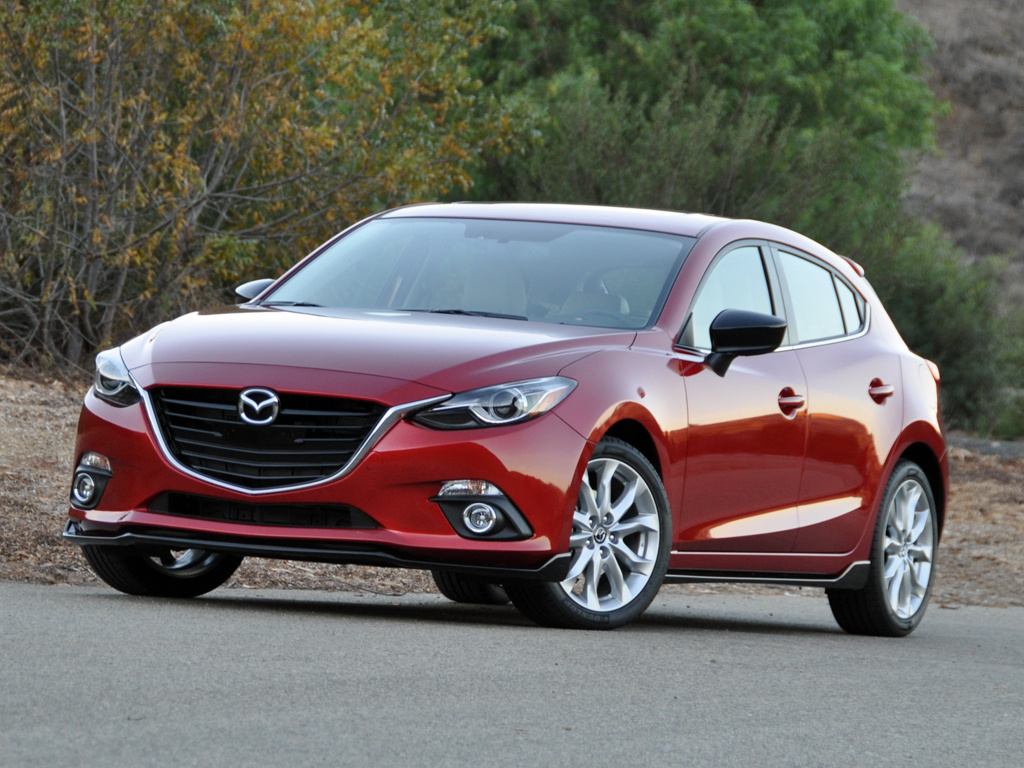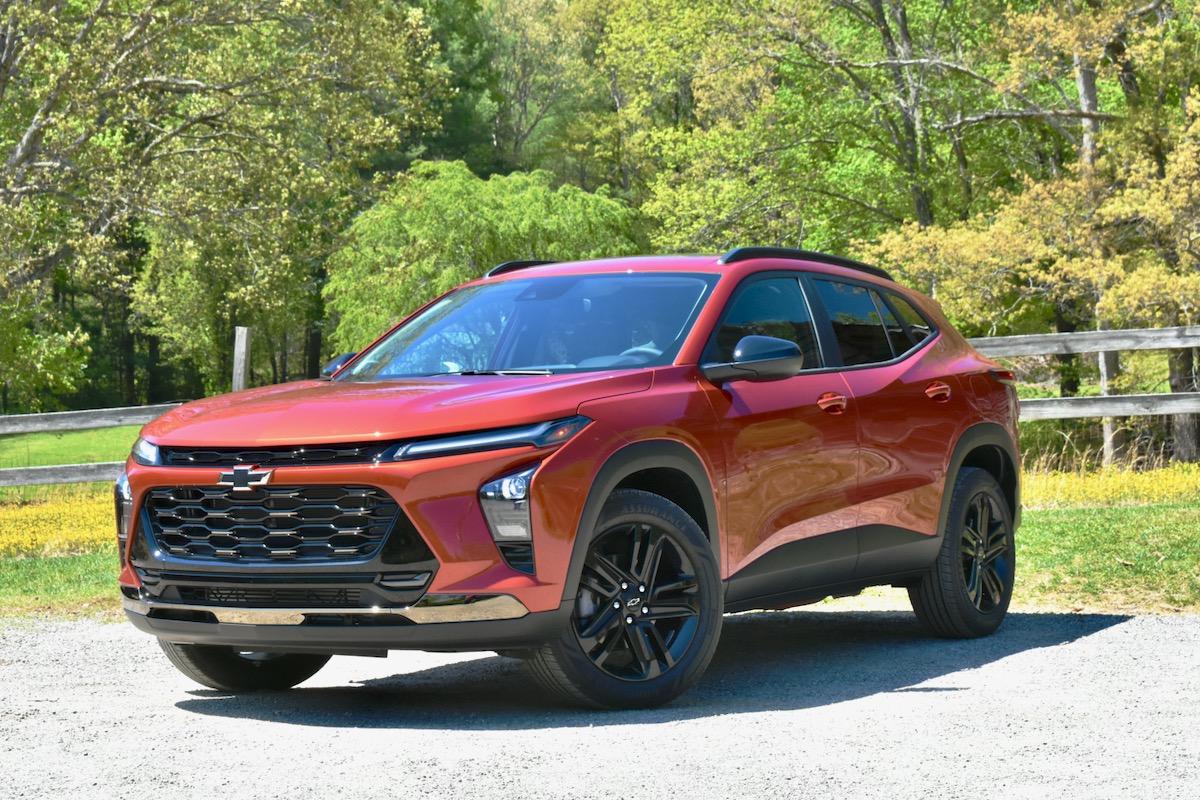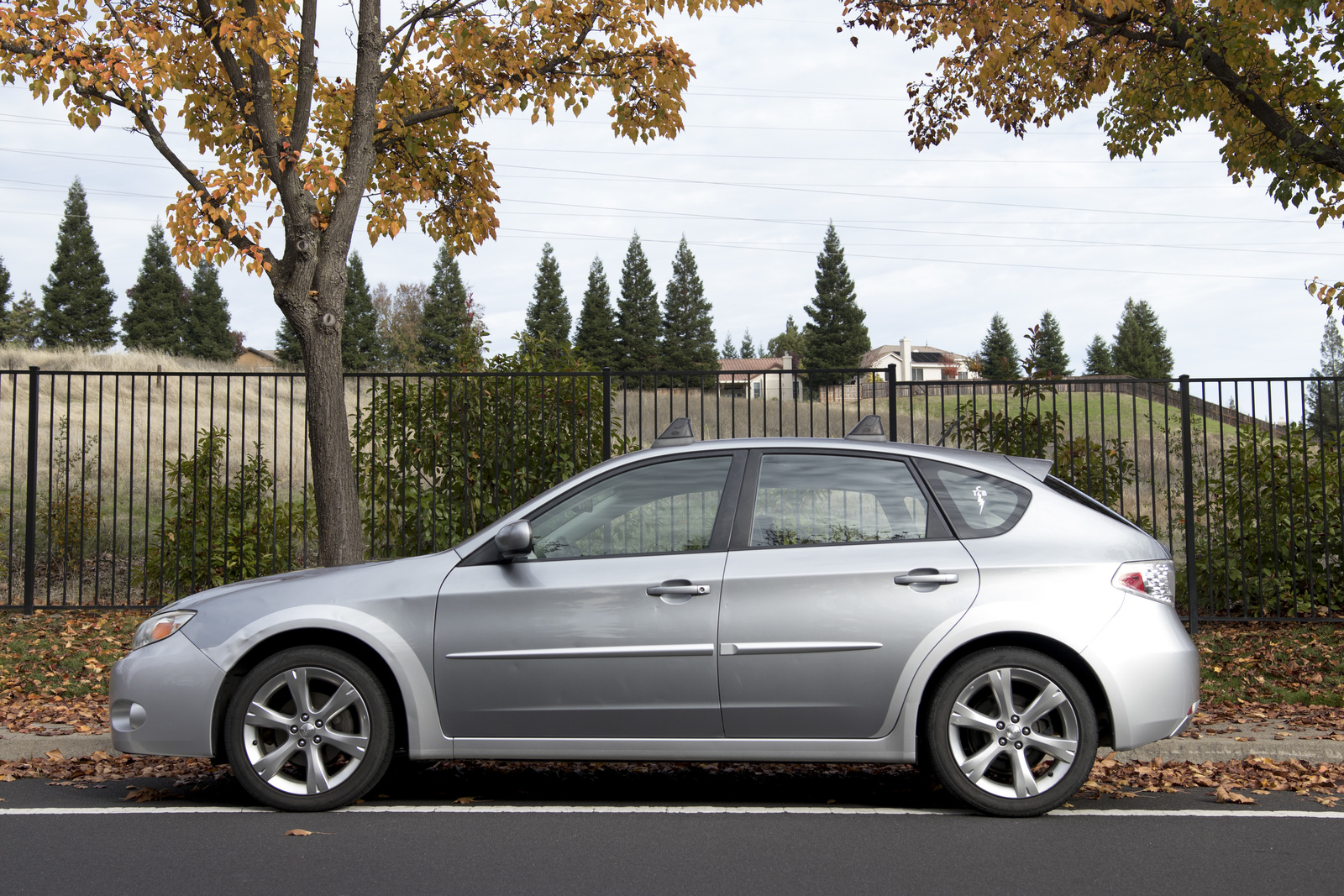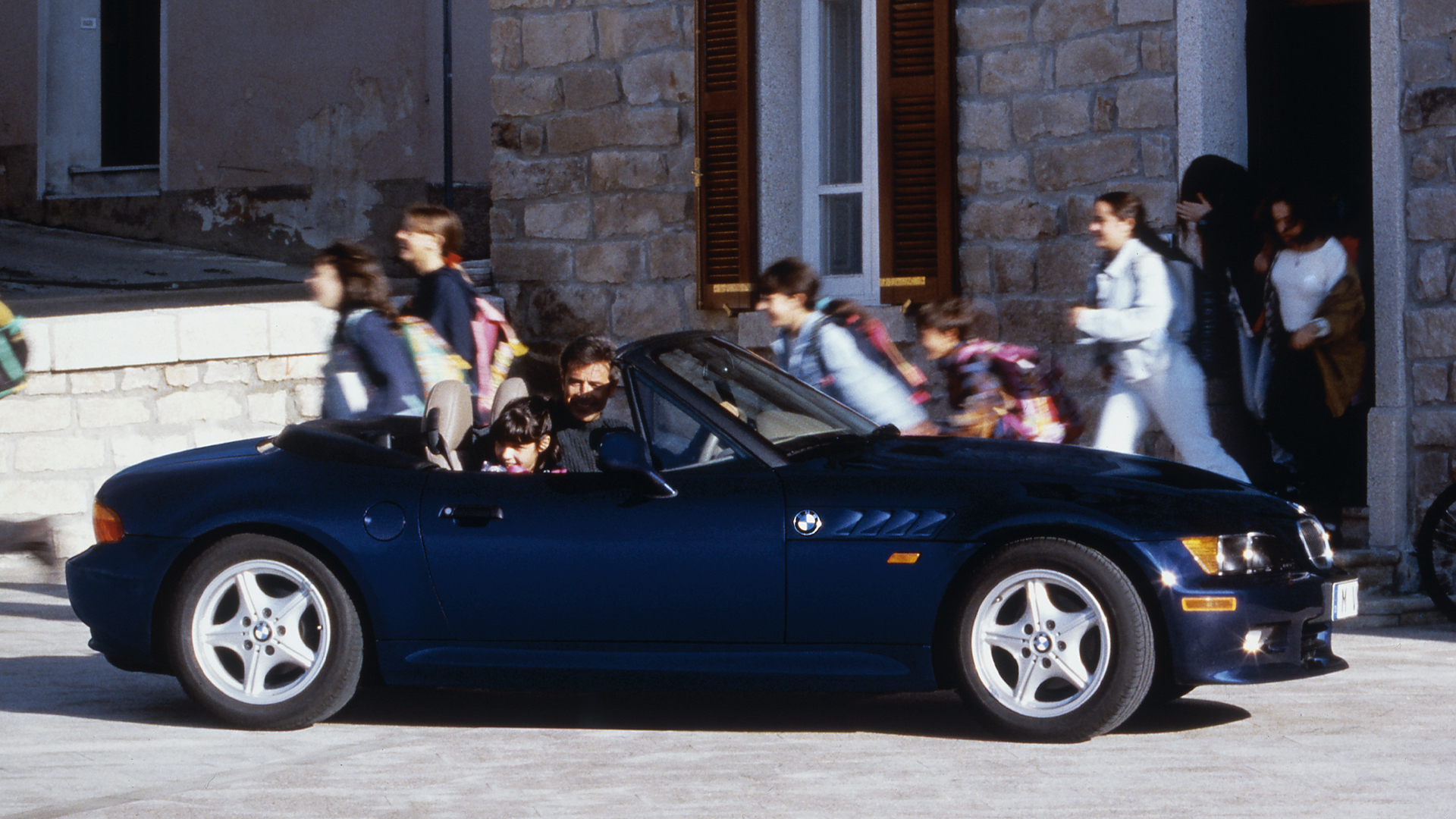The Mazda3 offers more excitement and drama in the way it drives—as well as the way it looks—than many affordable compact cars. Body styles on offer include a four-door sedan and a five-door hatchback. The model was first introduced in 2004 as a successor to the Mazda Protege, which was a solid and sensible vehicle but not exactly exciting. The Mazda3, on the other hand, was a much more exciting, desirable package that combined value for money, a spacious interior and impressive levels of passenger and driver comfort with an enjoyable driving experience and sleek design, making it stand out in a market of stolid econoboxes.
Since then, each new generation of Mazda3 has followed a similar formula, bringing extra tech and sophistication but retaining the same sense of fun, making it one of the best compact cars to drive—which is exactly why you’ll find it in the rankings so many of our best cars articles.
While the first- and second-generation Mazda3 models share their platform with the concurrent Ford Focus, those since have been Mazda creations and all four offer a bit more involvement and precision than the average compact car. Power comes from four-cylinder engines that are eager to rev and fuel economy is reasonably good, especially post-2012 models that feature Mazda’s ‘Skyactiv’ technology, which compresses fuel and air at an especially high ratio to deliver improved fuel efficiency and lower emissions. For maximum fun, there’s the Mazdaspeed3 – an upgraded high-performance variant of the first two generations with some choice mods, a turbocharged engine, and a near-ludicrous (for the time) turn of speed.
Creature comforts and tech features have increased over time. The lower-cost versions of the first-generation car had fairly rudimentary equipment, but by the third generation, the Mazda3 was well-equipped across all trim levels yet still reasonably affordable. The current, fourth-generation car is loaded with high-tech features that reflect its elevated image and sticker price. Refinement and safety features have increased significantly over the Mazda3’s lifespan, too, both of which were somewhat lacking in first-gen models.
Mazda has a generally solid reputation for reliability, although its cars tend not to be as durable as those of its Japanese counterparts Honda and Toyota. Earlier Mazda3 hatchback and Mazda3 sedan models are now 20 years old, so finding one that’s still in good health might be a challenge, especially since they’re prone to fairly major transmission and rust issues. The third-generation car has a few foibles too (more on that below), but the latest version is proving durable and, on the whole, the Mazda3 is well worth considering due to the value, style and driver appeal it provides.
Here’s our comprehensive buying guide, covering each generation of the Mazda3, what to look out for and how much you should pay.
Mazda3 Buying Guide: Cost, Reliability, and the Best Years to Buy
- Frequently Asked Questions
- Mazda3 Pros and Cons
- Mazda3 Generations
- Mazda3 Fourth Generation (2019-Present)
- Mazda3 Third Generation (2014-2019)
- Mazda3 Second Generation (2010-2014)
- Mazda3 First Generation (2004-2009)
Frequently Asked Questions
Which Mazda3 years are the best?
The 2014-2019 Mazda3 is a great car at a great price, but it’s hard to argue a case against the current, post-2019 Mazda3 being the best iteration. It’s a stunning-looking car that’s packed with tech, great to drive and has a genuine premium feel. It’s also, so far, proving the most reliable version yet.
What are the worst Mazda3 years?
Both the first- and second-generation Mazda3 models can be troublesome, but the 2010 Mazda3 seems to be the worst for reliability. This is the first year of the second-gen model, and data from carcomplaints.com suggests that cars with a manual transmission are plagued by clutch problems. The first-gen Mazda3 can suffer from transmission issues and also rust badly. The two most recent models are much newer and appear better for reliability so far, although brake problems are mentioned frequently by owners of the 2014-2019 model.
Is a used Mazda3 a good deal?
The Mazda3 can be a good deal if you’re looking for a compact car that gives you a bit more style and dynamism than most mainstream rivals and is keenly priced. Earlier cars are very affordable, but it’s worth stretching to the two most recent versions if you can. They should be less likely to suffer from faults and they’re well-equipped cars with a contemporary, premium feel.
Mazda3 Pros and Cons
Pros:
- Stylish and sporty
- Fun to drive
- Good value for money
Cons:
- Reliability concerns over older cars
- Entry-level first-generation cars aren’t that well equipped
- Some rival cars are quieter and more practical
Mazda3 Generations
Mazda3 Fourth Generation (2019-Present)
If the third-generation Mazda 3 saw the model take a step upmarket, the fourth-generation Mazda3 took a giant leap, becoming a genuine – and drop-dead gorgeous – alternative to premium-brand rivals such as the Audi A3. As before, you can choose from Mazda3 hatchback or Mazda 3 sedan models, and this time round the hatchback is much sleeker, with coupe-like rear styling. The interior is as delectable as the exterior, with a simple, sporty layout, supportive front seats, and high-quality materials. Practicality and rear visibility suffer a little due to the hatchback’s tapered roof and window line, yet it remains a practical car.
The third-gen Mazda3 was initially available with one engine: a 2.5-liter Skyactiv unit with 186 horsepower, with most versions having a six-speed automatic transmission as standard – only the top-spec hatchback models were available with a six-speed manual. For the first time on a Mazda3, all-wheel drive (labeled i-Activ AWD) was available with some models. The 2021 Mazda3 model year added an entry-level version of the sedan with a 155-horsepower 2.0-liter engine (the only one that gives more than 30mpg combined). It also introduced the Mazda3 2.5 Turbo – a range-topping model with 250 horsepower (227 with regular fuel) and 320 lb-ft of torque (310 with regular fuel), a six-speed automatic transmission and AWD. This top-spec model has the performance, equipment and driving appeal to justify an MSRP of $30,000+ when new. In fact, it’s a bargain.
Mazda has tweaked the Mazda3 model line-up numerous times since 2019, but the core trim levels are base, Select, Preferred, Premium, and 2.5 Turbo. You’ll find a range of other configurations available, including S, S Select Sport, 2.5 Turbo Premium Plus, Carbon Edition, and 2.5 Carbon Turbo models. All are very well-equipped, with features including alloy wheels, cruise control, LED headlights, and lots of advanced i-activsense safety features. All but the early entry-level sedan versions have a blind-spot monitoring system, dual-zone climate control, and support for Apple CarPlay and Android Auto, while higher-spec versions, including the 2.5 Turbo, have a Bose premium audio system and electric driver’s seat adjustment. The 2.0-liter sedan model was dropped in 2023.
While the previous Mazda3 models don’t have the kind of reliability records you might expect of the brand, the post-2019 car is holding up well so far. Owners have reported a few issues with the air-con but there are no major concerns. In fact, the Mazda3 was second only to the Honda Civic in the compact category of the 2024 Consumer Reports Annual Auto Survey reliability survey of three-year-old cars and SUVs.
As a new car, the MSRP for the Mazda3 has ranged between $21,000 and about $37,000. High-spec and AWD versions put it into headier territory than before, but they are well-equipped, and all versions are good value. Used prices start at about $13,000 for a car with average mileage, while you should expect to pay at least $19,000 for a 2.5 Turbo model that’s been well looked after.
Mazda3 Third Generation (2014-2019)
The third-generation Mazda3 represented a big shift from the conservative nature of the second-generation car, with a sleeker exterior and a focus on higher quality throughout. In fact, it looks and feels more like a European premium brand model, yet it remains competitively priced. Introduced in 2014, it has almost identical dimensions to its predecessor but its long bonnet and sculpted sides give it a low-slung, sporty appearance with hints of Alfa Romeo and BMW. The interior is similarly stylish, with a premium, driver-centric look.
As before, Mazda3 hatchback and Mazda3 sedans were available and there’s a choice of 2.0-liter or 2.5-litre ‘Skyactiv’ engines, with 2.0 versions called Mazda3i and 2.5 versions wearing a Mazda3s badge. Each was available new with either a six-speed manual or six-speed automatic transmission although earlier 2.5 models were auto-only. This time round there was no Mazdaspeed3. The Skyactiv engines don’t offer the low-down punch of the turbocharged engines that were starting to become common in rival cars at the time, but they rev easily and, driven sensibly, return excellent mpg, by both real-world and EPA criteria.
Trim levels for the third-gen Mazda3 are SV, Sport, Touring and Grand Touring. Standard features were good for their time, although the entry-level SV (Special Value) missed out on Bluetooth and alloy wheels. At the other end of the spectrum, Grand Touring models include features such as electric driver’s seat adjustment, keyless entry, and Mazda Connect – an infotainment system featuring a seven-inch display, satellite navigation, rear-view camera, and satellite/internet radio integration. One quirk of the Mazda Connect system of this era is that you control it using a BMW i-Drive style dial on the center console when the car is moving and, when stationary, it also functions as a touchscreen. A mid-life update in 2016 brought minimal changes, with some minor cosmetic and trim upgrades. The naming strategy and trim levels changed at this point, too, with the ‘i’ and ‘s’ suffixes for each engine dropped – now, all versions were simply badged Mazda3.
The 2014-2019 Mazda3 looks and feels like a well-engineered product, but although generally solid, it isn’t generally as reliable as a Toyota Corolla or a Honda Civic. Premature brake wear is a common issue, especially with pre-facelift cars, while the infotainment system can be glitchy.
Despite the shift upmarket, the Mazda3 remains a cost-effective option that undercuts many rival cars on price. You can pay as little as $9,000 for an early sub-100,000-mile car in SV or Sport trims, but it may well be worth an extra $2,000 or so for a Touring model that’s covered fewer miles and has more high-tech features.
Mazda3 Second Generation (2010-2014)
The second-generation Mazda3 was a fine replacement for the first-generation car, even if it suffers from a little ‘second-album syndrome’. It’s a solid follow-up that covers all the bases but it’s less characterful and edgy, with its smiley ‘face,’ softer lines, and rather bland interior. Despite this, it’s similarly enjoyable to drive and adds some welcome extra comfort and equipment to the mix.
Introduced in 2010, the second-generation Mazda3 is basically an upgraded version of its predecessor, with the same front-wheel drive chassis and almost identical dimensions. The model line-up is similar, with a choice of Mazda3i models with a 148 horsepower 2.0-litre engine or Mazda3s models with a 2.5-liter engine pushing out 167 horsepower. The 2.0 came with a five-speed manual or a five-speed automatic transmission, while the 2.5 has a six-speed manual or the same five-speed auto. Both engines are keen to rev and give reasonable mpg, according to EPA ratings.
SV (Special Value), Sport, Touring, and Grand Touring trim levels provide increasing levels of equipment. We’d suggest the Mazda3i Touring or Mazda3s Sport models for the best blend of value and equipment, because the lowest-spec Mazda3i versions didn’t initially get alloy wheels or stability control as standard. Music lovers should look out for cars with the premium Bose premium audio system (an option for most trims) and, if you want outright pace and thrills, there’s the Mazdaspeed3 – a beast of a car with 263bhp driving the front wheels, upgraded brakes and suspension, and a sporty makeover inside and out.
A range update in 2012 included minor design changes (with less of a goofy grin at the front ), extra strengthening for a sharper drive, and a range of spec upgrades. It also added a new engine option – a 155-horsepower 2.0-litre with Mazda’s ‘Skyactiv’ technology, giving more power but better mpg than the standard 2.0-liter engine, plus a choice of a six-speed manual or a six-speed automatic transmission.
The second-generation Mazda3 is now at an age where its service history and mileage are crucial to how much it’ll cost you to buy and maintain, and there are a number of issues to look out for. Early manual models were notorious for clutch failures, while transmission faults and melting dashboards afflict most model years. Prices are fairly low, with high-mileage cars starting at about $3,500. We’d say it’s worth doubling that for a post-2012 model with less than 100,000 miles on the odometer, but really good examples – and Mazdaspeed 3 versions – will cost upwards of $10,000.
Mazda3 First Generation (2004-2009)
The first-generation Mazda3 was the second example (after the Mazda6) of Mazda bringing some of the zesty character of its MX-5 Miata to its mainstream models. More fun to drive than most other compact cars, it was also sharply styled inside and out and very affordable. Five-door hatchback and four-door sedan body styles were offered and both look great, but the Mazda 3 sedan’s sleeker roofline and BMW-esque rear end have arguably aged better.
There were two four-cylinder engines available from launch: a 2.0-liter with 148 horsepower in the entry-level Mazda3i or a 2.3-litre with 160 horsepower in the better-equipped Mazda3s. A five-speed manual transmission or a four-speed automatic was available for both and all models are front-wheel drive. Fuel economy is about average, with combined mpg sitting somewhere around the 25mpg mark depending on the model, according to EPA ratings. Prices when new were extremely competitive, although Mazda3i versions aren’t that well equipped. Air con and dual airbags are included, but you need to step up to the Mazda3s version for power windows and mirrors, and alloy wheels. Higher-spec Mazda3 Touring and Mazda3 Grand Touring versions – as well as a number of special-edition models – arrived later with more kit , some featuring an excellent Bose sound system as standard or as an option.
A facelift in 2007 brought some cosmetic and chassis upgrades, as well as revised trims and specs. There were improved sound deadening measures, too, although the Mazda3 remained rather noisy compared with some rivals. The update also saw the introduction of the Mazdaspeed 3 – a high-performance version of the Mazda3 hatchback with a turbocharged 2.3-liter engine pushing out 263 horsepower, and a range of chassis and cosmetic upgrades. Although riotously fast and fun, all that power can overwhelm the front-wheel drive chassis (some rival cars have AWD), despite the addition of a limited slip differential.
Mazda has a good reputation for reliability that the first-gen Mazda3 doesn’t always live up to. Transmission problems are the most common issues on earlier cars, according to carcomplaints.com, while engine faults can arise, and rusting bodywork can be a major problem, especially if the car comes from one of the snowier states. You shouldn’t have to pay much for a Mazda3 of this era, though. It was great value when new and you can now pick up high-mileage examples for $2,000 or less. Somewhere between £5,000 and $8,000 will get you a tidier car with fewer than 100,000 miles, while a Mazdaspeed3 in decent condition is likely to cost at least $10,000.






